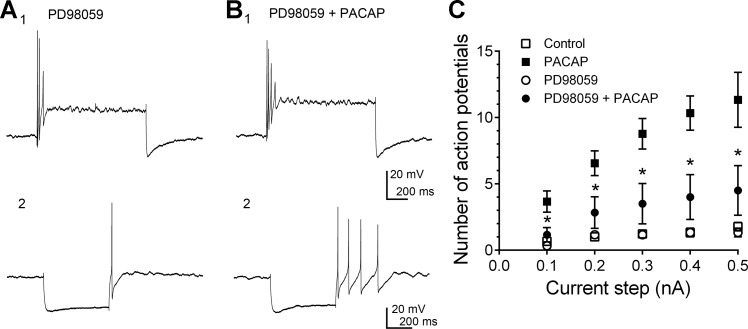Fig. 3.
MEK inhibitor PD 98059 pretreatment suppresses the PACAP-induced increase in excitability without suppressing the rectification in constant-current-elicited hyperpolarizations or hyperpolarization-induced rebound depolarization. A: MEK inhibitor PD 98059 treatment blunted the PACAP-induced increase in neuronal excitability. A1: in inhibitor-pretreated cells, prior to PACAP, a 1-s, 0.3-nA current step elicited 3 action potentials. B1: during exposure to PD 98059 + PACAP, 4 action potentials were elicited by the same stimulus. A2: in PD 98059, prior to PACAP exposure, some rectification was evident in the hyperpolarization elicited by a 500-ms constant-current step, and a hyperpolarization-induced rebound depolarization at the termination of the hyperpolarization was large enough to generate an action potential. B2: during exposure to PD 98059 and PACAP, rectification in the hyperpolarization was more evident and the hyperpolarization-induced rebound depolarization elicited multiple action potentials. C: averaged excitability curves generated by plotting the number of action potentials elicited by 1-s depolarizing constant-current steps of increasing strength. Data are shown for 1 group of cells exposed only to PACAP and for different cells exposed to PD 98059 + PACAP. □ and ■, Averaged excitability curve generated for 9 cells before PACAP and then during exposure to PACAP (5 cells at 10 nM and 4 cells at 20 nM); ○ and ●, averaged excitability curve generated for 6 cells exposed only to 50 μM PD 98059 and then the same cells exposed to PD98059 + PACAP (3 cells at 10 nM and 3 cells at 20 nM). *Number of action potentials generated in cells exposed to PACAP + PD 98059 was significantly less than those exposed to PACAP alone at the same current step.

